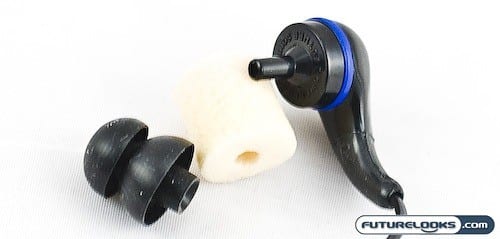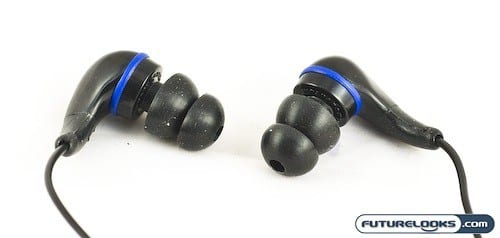Setup and Break In
If you aren’t into reading manuals, here’s the long and short of it. Make sure you run the headphones at a moderately high volume for at least 100 hrs before sampling them and try all the sizes of ear pieces before settling on a comfortable set. Future Sonics also asks that you turn off all EQ and Bass Boost settings before plugging in as well.

The Atrio’s need to sit in your ear properly to do their job. While the foam earpieces will give you the best seal, the silicon ones are far more practical for daily use, especially at the gym where sweat will collect in them and turn them…crusty…for a lack of a better description. The silicon ones are also easier to take off and clean. Taking the earpieces on and off is easy and require just a push to get them on or a pull to get them off.
Sound Quality and Comfort
Two things that are very important for any headphone is how they sound and how comfortable they are. After getting them broken in properly and selecting the right sized earpieces, it was time to take a listen. I used my 80GB Microsoft ZUNE as the source for all tests. Here’s what I found out.
One thing you’ll notice off the bat is that both earpiece types will provide a slightly different sound. The silicon ones will sound noticeably brighter while the foam ones provide a slightly flatter sound, but also provide a bit better bass response. On that note, bass response was superb. It was deep and accurate (more so with the foam tips) and really warmed up the sound as it crossed to the mid-range. As for comfort, I actually preferred the fit of the silicon tips, but preferred the sound quality of the foam tips.
The mid-range is very detailed and you will be able to pick out sounds that you won’t hear when compared to a lot of lower end headphones. My SONY MDR-EX71SL in ear phones were totally out classed by these, despite being about $80 US when I first purchased them. Even my industry standard SONY MDR-7506 studio monitors couldn’t bring out the mid-range and blooming bass that these put out.
One thing that is a characteristic, love or hate, about true studio monitoring headphones is how they bring out the best (and worst) of a track. If the recording is bad or low quality, it won’t sound any better with the Atrios. In fact, they’ll sound worse. It was no coincidence that tracks recorded by artists that Future Sonics has recognized as using their products, sounded a better overall. Go figure.
Overall comfort with both earpieces was very good, though I did prefer the silicon tips for comfort and day to day use. The weight of the headphones was good as they were never a burden to me. Like most headphones that sit in your ear canal, if you eat crunch foods, they do get amplified in your ears.
Final Thoughts and Conclusions
The Future Sonics Atrios Series Professional Earphones stay true to their “EarMonitor” heritage: They will show you exactly what was recorded without sugar coating. Depending on how your music was recorded (or the quality they were ripped at) this could be good or bad. Bad gets worse, but good gets better if that makes any sense. I also really liked the fact that very little volume was required to get good resolution from your music, which prolongs your comfort, allowing you to listen to them all day long without fatigue.

Having a selection of two types of tips and sizes to pick from does provide an almost custom fit. Again, I did notice that the foam tips provided the best sound, but I did prefer the silicon ones for day to day use. They will also prove more durable as the foam ones will break down quicker, especially if you get a lot of sweat on them. The totally custom option for $149 US is an option down the road.
If you’re looking for some very portable monitoring headphones, then the Future Sonics Atrios are hard to beat (unless you get their $898 US EarMonitors). However, if you’re scared of hearing how good or bad a recording really is, you might want to look at other options. They might not be for everyones, but if you’re the right listener, picky and kind of an audio geek, then you’ll like these.
Pros
- Lets you finally hear just how good a recording can be
- Provides almost a custom fit with wide array of tips
- Can be listened to at fairly low volumes without sacrificing sound quality
Cons
- Sound quality might be too brutally honest for some ears
- What? No 1/4″ adapter or airline adapter?
Overall Rating: 9.0 / 10.0

Discuss This Review in the Futurelooks Community Forums
